Advanced Filter Options
Advanced filter options provide powerful ways to refine searches and manage fact sheets. These options allow for complex queries, making it easier to find and organize specific architectural elements within your IT landscape.
Introduction
Advanced filter options in SAP LeanIX allow you to refine your filter criteria, combine AND, OR, and NONE logic, allow filtering by fields on relation, invert applied filters, and more for effective search. In this guide, you can also learn about using lifecycle and subscription filters.
Before diving into advanced filtering, refer to the basic guide on searching and filtering. See Searching and Filtering in the Inventory.
Advanced Filtering
Advanced filtering allows you to refine your filter criteria for more specific results. The filter panel on the left might not list all the filter criteria to keep the layout clean and user-friendly. For example, if you want to find applications used by a particular level 2 business capability, you can use advanced filtering to find the level 2 business capabilities.
Advanced filtering also allows you to filter the filter criteria by related fact sheet types. For instance, assume you want to identify all applications that support business capabilities associated with the customer's online purchase journey. First, using the advanced filter option, filter the specific business capabilities associated with the online purchase journey. Then apply those business capabilities as filters to identify all the applications supporting those business capabilities.
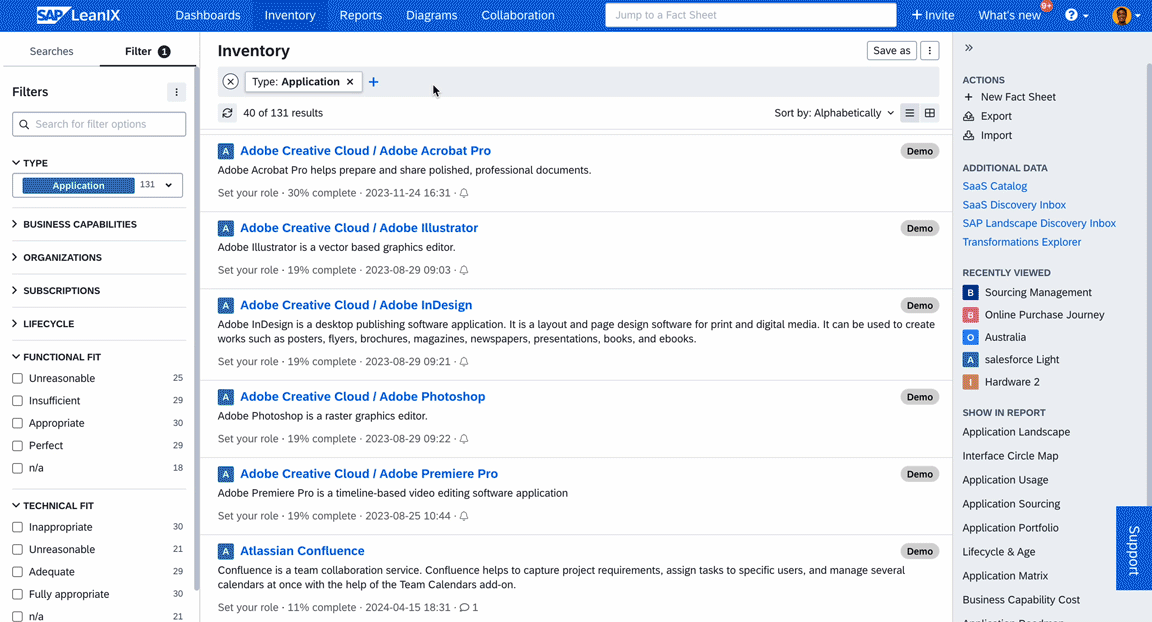
Advanced Filtering in Inventory
Combining Filters with AND, OR, and IS NOT Logic
You can fine-tune your search results using filters with AND, OR, and IS NOT logic. These filters help you include or exclude specific fact sheets, tags, and other criteria. Here's how each operator works:
- OR: Shows results that match at least one of the selected items.
- AND: Shows results that match all of the selected items.
- IS NOT: Excludes results that match any of the selected items. This is helpful for inverting the applied filters to have a list of all fact sheets not related to the applied filters.
You can select these options in the filter group settings by clicking the gear icon in either the filter panel or the filter bar.
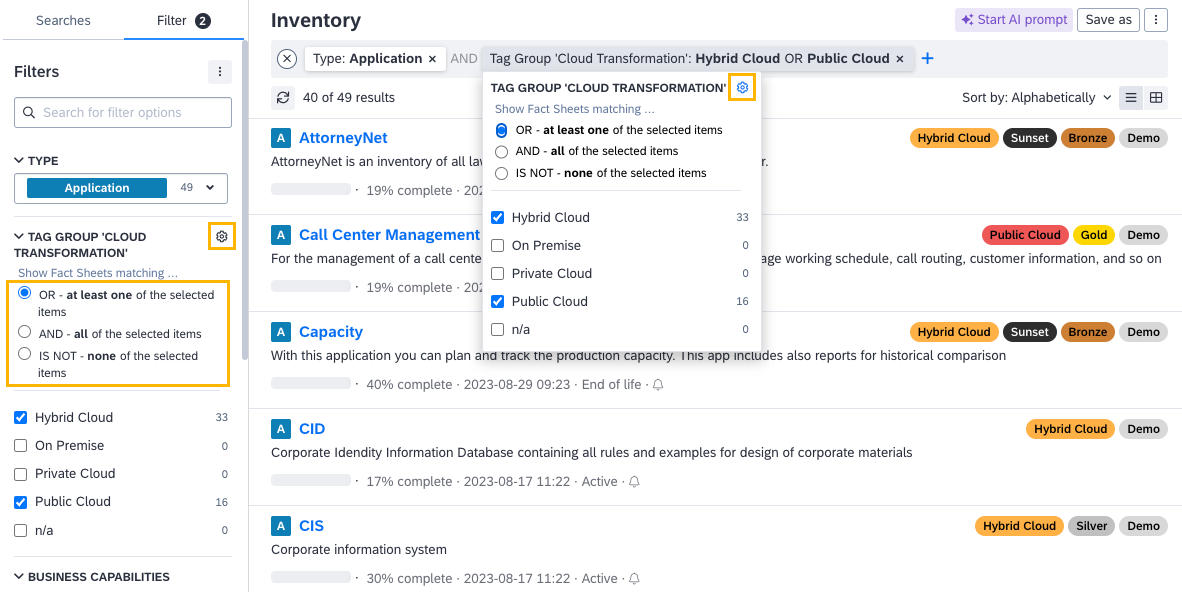
Combining Filters with AND, OR, and NONE Logic
Note
When applying related fact sheets as filters, use the advanced filter to see the complete list of related fact sheets. To learn more, see Advanced Filtering.
Filtering by Fields on Relation
You can use fields on relation as filter criteria to refine your search and gain better insights. Here are a few example queries that can be answered using fields on relation as filters:
- All applications owned or used by an organization and not just related to an organization.
- All applications where marketing is the leading business capability.
- All applications where the data object 'Customer' is created or updated.
- All IT components approved for the tech category 'Middleware'.
At the bottom of a filter group, the Add field filter drop-down list includes all default and custom fields on relations that you can select as filters. Select the necessary field from the list to apply the filter. You can select multiple fields in one search. Additionally, you can apply fields from multiple relations simultaneously by selecting the + Add relation field button, which appears after you have used at least one field on a relation as a filter.

Filtering by Fields on Relation
Inverting Applied Fields on Relation Filter
You can invert the applied filter in the filter group settings by clicking the gear icon in either the filter panel or the filter bar and then selecting none of the relation field filters.
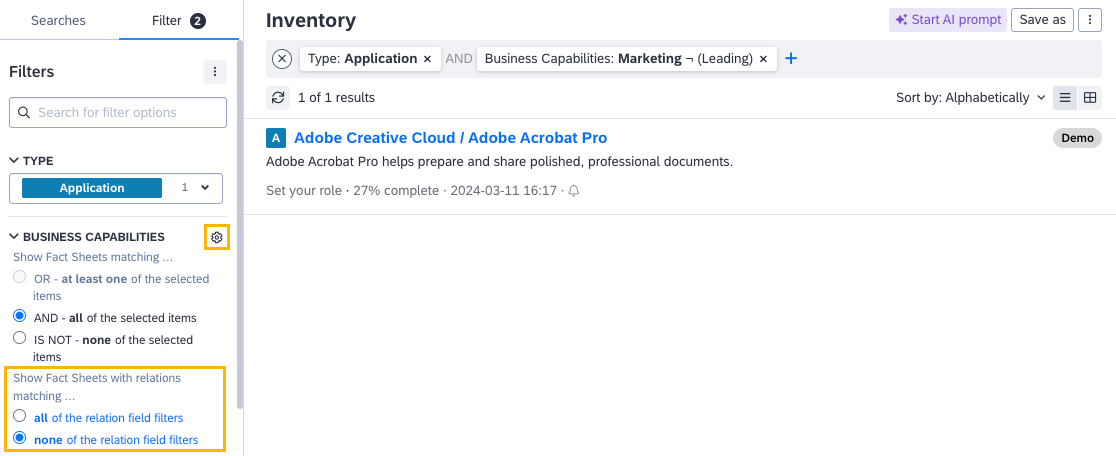
Inverting the Fields on Relation Filter
Tip
In single-select and multi-select fields on relation, 'n/a' is also an option. When you want to apply 'n/a' as a filter, select all the values of the field as filters and then simply invert it.
Making Fact Sheet Fields Available as Filter Options
If certain fields on relations are not available in the filter options, it means they are not configured to be shown in filters. You can configure these fields by enabling the Show in filters toggle in the fact sheet configuration. For details, see Showing Fields in Filters.

Configuring Fields to be Shown in Filters
Using the Lifecycle Filter
The lifecycle filter enables filtering of fact sheets by their lifecycle state: plan, phase-in, active, phase-out, and end-of-life. It is useful for viewing your architecture at a specific point in time. This capability allows you to easily analyze your target architecture landscape, provided that you have also modeled successors effectively.
In the context of application fact sheets, you can filter by the following lifecycle states:
- Plan: Filter applications that are still in the planning stage and it is unclear whether they will be implemented or introduced.
- Phase In: Filter applications that are in the phase of being built or acquired.
- Active: Filter applications that are productive and in active use.
- Phase Out: Filter applications that will be retired at the end of this phase
- End of Life: Filter applications that are not in use.
- Any: Filter applications that are in any lifecycle state, including those without lifecycle information, except for fact sheets in the end-of-life state.
Note
The lifecycle state can have slightly different meanings depending on the fact sheet type. Check the help texts in the fact sheet itself to understand what the lifecycle phases mean for each type.
A lifecycle filter can be applied to a specific point in time or over a time frame by selecting the needed options from the lifecycle filter.
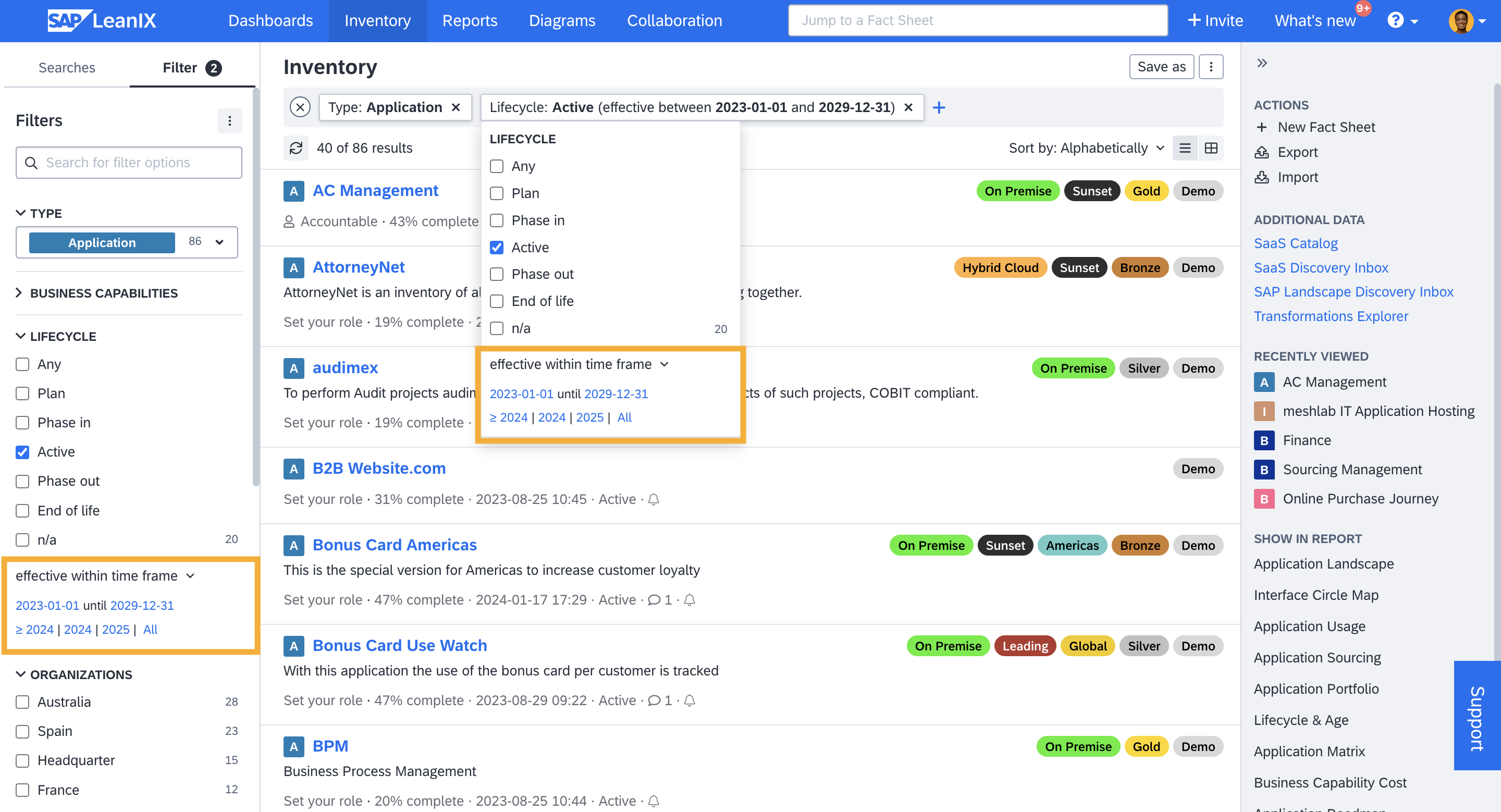
Applying Lifecycle Filters Based on Time
You have the following options:
- Effective Within Time Frame: Filters fact sheets that are in the selected lifecycle state at any point during the specified time frame.
- Starts Within Time Frame: Filters fact sheets that begin the selected lifecycle state within the selected time frame.
- Ends Within Time Frame: Filters fact sheets that end the selected lifecycle state within the selected time frame.
- Point of Time: Filters fact sheets that are in the selected lifecycle state at a specific point in time. You can also choose Today, End of Month, and End of Year for quick and easy filtering.

Applying Lifecycle Filters for a Point of Time
Note
When combined with a relation filter, the lifecycle filter also takes the relation Active from/Active until fields into consideration.
Filtering by Subscriptions
Filtering by subscriptions enables you to find fact sheets based on subscribers or specific subscriber roles, as well as those without any subscribers. This is particularly valuable when you have to identify fact sheets without subscribers so as to assign ownership and maintain accountability effectively.
In the subscriptions filter group, select My Subscriptions to list all fact sheets you have subscribed to. Similarly, selecting the name of another user allows you to view the fact sheets they are subscribed to. You can further refine the list based on subscription type or subscription role by selecting the appropriate type and role from the Type / Role filter drop-down list.
Note
If the subscription filter group is not visible in the filter panel, you can make it visible through the Manage Filters settings. To learn more, see Displaying and Hiding Filters.
Listing the Fact Sheets Without Subscriptions
In the subscriptions filter group, select ‘n/a' to list all fact sheets without subscriptions.
Further, if you select a subscription type or role from the drop-down list below, all fact sheets without subscriptions of that type or role are also added to the list, even if those fact sheets have another type of subscription. So, in effect, selecting ‘n/a' and a particular subscription type or role gives you the list of fact sheets without a subscription of that type or role.
Listing All Fact Sheets with a Specific Subscription Type or Role
To list all fact sheets with a specific subscription type or role, do the following:
- In the Subscriptions filter group, select ‘n/a' to list all fact sheets without subscriptions.
- Select a subscription type or role from the drop-down list below. This lists all fact sheets without subscriptions of that type or role.
- From the filter group settings (gear icon), select IS NOT - none of the selected items. This inverts the previous list to show all fact sheets with that specific subscription type or role.
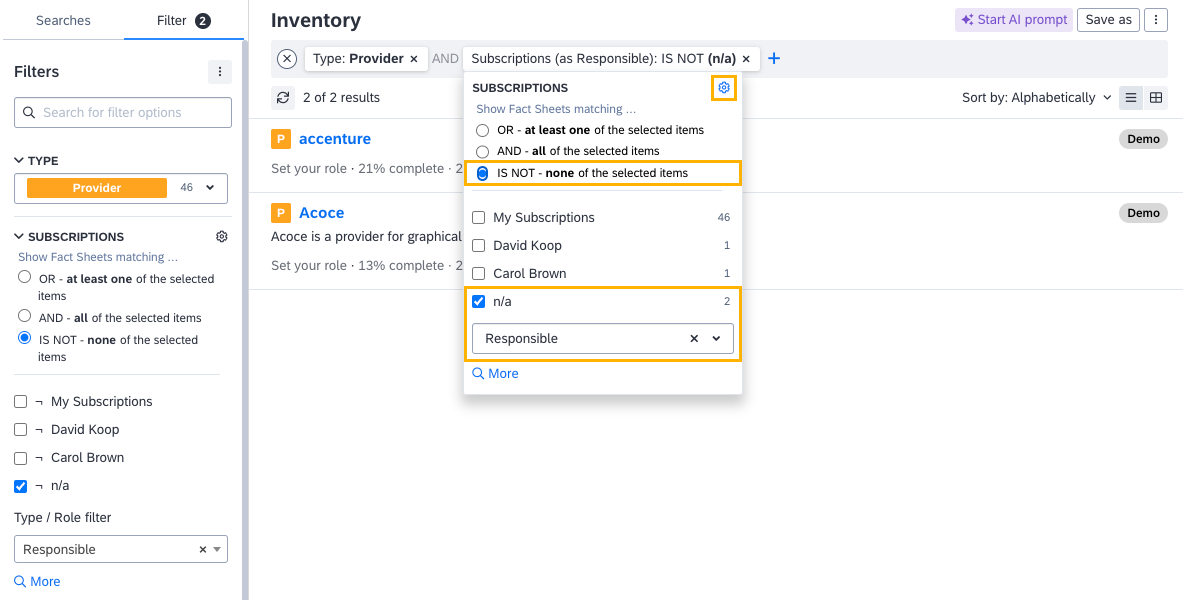
Listing All Fact Sheets With a Specific Subscription Type or Role
Updated 5 months ago
